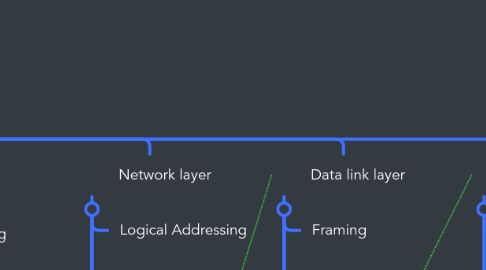
1. LAYERS
1.1. Application layer
1.1.1. Interface
1.1.2. FTAM( File transfer access & Management)
1.1.3. Directory services
1.1.4. Remote login
1.1.5. Mail services
1.2. Presentation layer
1.2.1. Translation
1.2.2. Encryption
1.2.3. Compression
1.3. Session layer
1.3.1. N/w dialogue Controller
1.3.2. Synchronization of data
1.3.3. Token management
1.3.4. Authentication/ Authorization
1.4. Transport layer
1.4.1. Service point addressing
1.4.2. Segmentation and Reassembly
1.4.3. Connection control
1.4.4. flow control
1.4.5. Error control
1.4.6. Congestion control
1.4.7. Multiplexing and Demultiplexing
1.5. Network layer
1.5.1. Logical Addressing
1.5.2. Routing
1.5.3. Quality of services
1.5.4. Congestion control
1.5.5. Fragmentation
1.6. Data link layer
1.6.1. Framing
1.6.2. Physical addressing
1.6.3. flow control
1.6.4. Error control
1.6.5. Access control
1.7. Physical layer
1.7.1. Physical characteristics
1.7.2. Representation of bits
1.7.3. datarate/transmission rate
1.7.4. synchronization of bits
1.7.5. Line configuration
1.7.6. Physical topology
1.7.7. Transmission modes
2. Data link layer
2.1. Error detection and correction
2.2. logic for error detection
2.3. Hamming distance/ minimum hamming distance
2.4. Linear block codes
2.5. Framing
2.6. Flow and error control
2.7. Access Control
2.8. Ethernet
2.9. Connecting Devices
3. Physcial layer
3.1. Digital Transmission
3.2. Transmission media
3.3. Guided Media
3.4. UnGuided Media
3.5. Multiplexing
3.6. Switching
3.7. Switching Modes
3.8. Switching Technique
4. Why OSI MODEL Failed ?
4.1. Reason
4.1.1. Bad timing
4.1.2. Bad Implementation
4.1.2.1. Huge
4.1.3. Bad Technology
4.1.3.1. over crowded
4.1.3.2. empty layers
5. Multiplexing
5.1. FDM
5.2. WDM
5.3. TDM
5.3.1. Synchronous TDM
5.3.2. Asynchronous TDM / Statistical TDM
6. transmisson modes
6.1. Parallel
6.2. Serial
6.2.1. Asynchronous
6.2.2. Synchronous
6.2.3. Isochronous
7. Performance of network
7.1. Bandwidth
7.2. throughput
7.3. Delays
7.3.1. Propagation Delay
7.3.2. Transmission Delay
7.3.3. Queing Delay
7.3.4. Processing Delay
8. Encoding techniues
8.1. Digital data to Digital
8.2. DIgital to Analog
8.3. Analog to digital
8.4. Analog to analog
9. Digital to DIgital Encoding
9.1. Unipolar
9.1.1. DC component
9.1.2. Synchronization
9.2. polar
9.2.1. NRZ
9.2.1.1. NRZ-L
9.2.1.2. NRZ-I
9.2.2. RZ
9.2.3. BIphase
9.2.3.1. Manchester
9.2.3.2. Diffrential Manchester
9.3. BIpolar
9.3.1. AMI
9.3.2. B8ZS
9.3.3. HDB3
10. digital signals
10.1. Bit interval
10.2. Bit Rate
10.3. Bit Length
10.4. Baud rate
11. Signals
11.1. Digital
11.1.1. periodic
11.1.1.1. Simple digital periodic
11.1.1.2. composite digital periodic
11.1.2. Apreodic
11.1.2.1. simple digital Aperiodic
11.1.2.2. composite digital Aperiodic
11.2. Analog
11.2.1. periodic
11.2.1.1. simple Analog periodic
11.2.1.1.1. Amplitude
11.2.1.1.2. Time-period
11.2.1.1.3. frequency
11.2.1.1.4. Phase
11.2.1.1.5. wave-length
11.2.1.2. composite Analog periodic
11.2.2. Aperiodic
11.2.2.1. Simple Analog Aperiodic
11.2.2.2. Composite Analog Aperiodic
